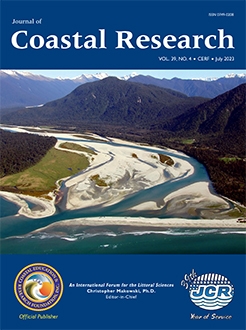Matthew T. Brown, Nicole Dix, Todd Osborne, Alicia Castle, Westly Woodward, Alison Hartnett, Shannon Dunnigan, Silas Tanner, Edward McGinley
Journal of Coastal Research 39 (4), 722-739, (4 July 2023) https://doi.org/10.2112/JCOASTRES-D-22-00070.1
KEYWORDS: nutrients, Ammonium, nitrate, Chlorophyll-a, phytoplankton, Turbidity, dissolved organic carbon, Hurricane, Matanzas River
Brown, M.T.; Dix, N.; Osborne, T.; Castle, A.; Woodward, W.; Hartnett, A.; Dunnigan, S.; Tanner, S., and McGinley, E., 2023. The impacts of a restoration dredging project and storm events on water quality in a northeast Florida barrier island estuary. Journal of Coastal Research, 39(4), 722–739. Charlotte (North Carolina), ISSN 0749-0208.
Previous studies in estuarine systems have demonstrated that both dredging projects and storm events can have profound impacts on water quality, particularly increases in nutrients, sediment loading, and shifts in phytoplankton community biomass. This study provided the opportunity to assess the potential relative impacts of a 9-month-long barrier island restoration dredging operation, in comparison to storm events that shortly followed, on water quality in a well-flushed, subtropical NE Florida estuary. Twice-a-month monitoring of turbidity, total suspended solids, chlorophyll-a, and major nutrients (ammonium, nitrate+nitrite, and orthophosphate) was carried out at six sites near the dredging operation area from November 2016 through October 2018. This timeframe sampled the dredging project from January to September 2017 associated with the reopening of the Summer Haven River on the barrier island side of the Matanzas River estuary. In addition, two major storm events, Hurricane Irma in September 2017 and a 5-day nor'easter in October 2017, took place during the water quality monitoring. Although the dredging project did result in notable impacts on total suspended solids and ammonium concentrations, the results highlight how natural storm events can have more significant and lasting impacts on water quality in a well-flushed estuary, particularly with regard to decreases in salinity, input and remineralization of dissolved organic carbon, and increases in dissolved nutrients.

